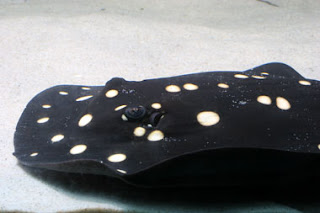One of my favorite aquarium fish freshwater is the Stingray, especially those of gender Potamotrygon. This fish is not for amateurs early, but if you have some experience it is a fascinating animal. There are many species of rays in the wild but you will find some species for sale in any shop of local fish. You can get a greater variety of species from specialized breeders online, but they are sold by their common names. For this reason, I will not use the scientific names in this article.
The lines are very sensitive to the parameters of the water. They have enough kidneys and they produce a lot of ammonia, make sure you have adequate filtration. The type of aquarium you keep them in very important because they remain at the bottom almost all the time, a shell with a large space at the bottom is the best, instead of a large reservoir closer. Rays get a fairly large tank for an adult specimen must be at least 4 feet by 2 feet, the height can be 2 feet. They are places of tropical and should have a temperature of about 75 ° to 80 ° F. The pH must be maintained in a range between 6.5 to 6.75 and keep the TDS (total dissolved solids) below 200.
When buying a new Stingray, stay away from specimens that have a "loop" of the disc, the so-called "death loop", since stingray while showing it will surely soon die. A healthy Ray always keep the margin flat on the hard substrate, unless moving actively on the shell. Some people speculate that this is due to renal failure, exposure over the animal to high levels of ammonia (as if they are in transit). Other signs of disease are:
- A cloudy or milky film on the body
- Rapid breathing or shortness of breath while at rest
- Open Wound
- Showing the pelvic bones, rays healthy does not present the bone.
Make sure its legal to keep lines in your state, some require special permits and sometimes they are limited to education or research facilities. Here is a list of states:
Arizona
Arkansas
Ca
Fl
Ga
Hawaii
Nevada
Oklahoma
Texas
Utah
It is a general guide to classify Stingrays:
Grand-Eyed
Black Rays
Tiger Ray
Ray Motoro
Ray Mantilla
Ray Otorongo
Ray chocolate
There are a number of Rays be sold as "water" while the rays which should be used to determine the size of the radius.
Small-Eyed rays
China Ray
Ray Antenna
Coly Ray
Ceja Ray
Manzana Ray
Be careful when considering the proper tank mates for these fish. Stingrays are not generally more aggressive towards fish, but do not mix them with something they can eat because I lost a few tetras, shrimp and even Cory catfishes. However, I had plecos that attach to the spokes, often boring, but in some cases, offensive.
Food is probably the most difficult part of keeping shelves. The first time you buy is sometimes difficult to get them to start eating and here is when I lost most of my shelves. I found they like squid, earthworms (still wriggling) and raw red meat. The feed at least twice a day.
The lines are very sensitive to the parameters of the water. They have enough kidneys and they produce a lot of ammonia, make sure you have adequate filtration. The type of aquarium you keep them in very important because they remain at the bottom almost all the time, a shell with a large space at the bottom is the best, instead of a large reservoir closer. Rays get a fairly large tank for an adult specimen must be at least 4 feet by 2 feet, the height can be 2 feet. They are places of tropical and should have a temperature of about 75 ° to 80 ° F. The pH must be maintained in a range between 6.5 to 6.75 and keep the TDS (total dissolved solids) below 200.
When buying a new Stingray, stay away from specimens that have a "loop" of the disc, the so-called "death loop", since stingray while showing it will surely soon die. A healthy Ray always keep the margin flat on the hard substrate, unless moving actively on the shell. Some people speculate that this is due to renal failure, exposure over the animal to high levels of ammonia (as if they are in transit). Other signs of disease are:
- A cloudy or milky film on the body
- Rapid breathing or shortness of breath while at rest
- Open Wound
- Showing the pelvic bones, rays healthy does not present the bone.
Make sure its legal to keep lines in your state, some require special permits and sometimes they are limited to education or research facilities. Here is a list of states:
Arizona
Arkansas
Ca
Fl
Ga
Hawaii
Nevada
Oklahoma
Texas
Utah
It is a general guide to classify Stingrays:
Grand-Eyed
Black Rays
Tiger Ray
Ray Motoro
Ray Mantilla
Ray Otorongo
Ray chocolate
There are a number of Rays be sold as "water" while the rays which should be used to determine the size of the radius.
Small-Eyed rays
China Ray
Ray Antenna
Coly Ray
Ceja Ray
Manzana Ray
Be careful when considering the proper tank mates for these fish. Stingrays are not generally more aggressive towards fish, but do not mix them with something they can eat because I lost a few tetras, shrimp and even Cory catfishes. However, I had plecos that attach to the spokes, often boring, but in some cases, offensive.
Food is probably the most difficult part of keeping shelves. The first time you buy is sometimes difficult to get them to start eating and here is when I lost most of my shelves. I found they like squid, earthworms (still wriggling) and raw red meat. The feed at least twice a day.

0 comments:
Post a Comment